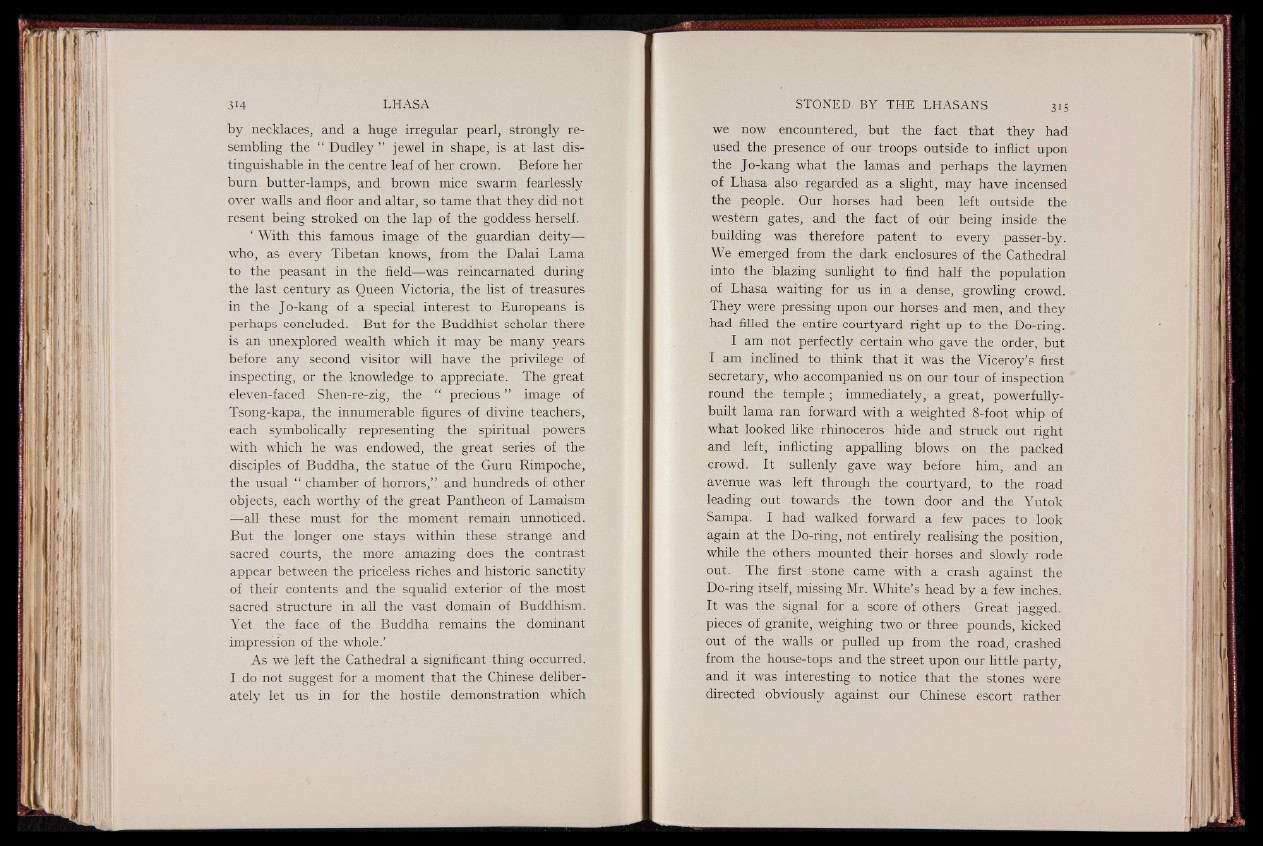
by necklaces, and a huge irregular pearl, strongly resembling
the “ Dudley ” jewel in shape, is at last distinguishable
in the centre leaf of her crown. Before her
burn butter-lamps, and brown mice swarm fearlessly
over walls and floor and altar, so tame that they did not
resent being stroked on the lap of the goddess herself.
‘ With this famous image of the guardian deity—j
who, as every Tibetan knows, from the Dalai Lama
to the peasant in the field— was reincarnated during
the last century a.s Queen Victoria, the list of treasures
in the Jo-kang of a special interest to Europeans is
perhaps concluded. But for the Buddhist scholar there
is an unexplored wealth which it may be many years
before any second visitor will have the privilege of
inspecting, or the knowledge to appreciate. The great
eleven-faced Shen-re-zig, the “ precious,” image of
Tsong-kapa, the innumerable figures of divine teachers,
each symbolically representing the spiritual powers
with which he was endowed, the great series of the
disciples of Buddha, the statue of the Guru Rimpoche,
the usual “ chamber of horrors,” and hundreds of other
objects, each worthy of the great Pantheon of Lamaism
g —all these must for the moment remain unnoticed.
But the longer one stays within these strange and
sacred courts, the more amazing does the contrast
appear between the priceless riches and historic sanctity
of their contents and the squalid exterior of the most
sacred structure in all the vast domain of Buddhism.
Y e t the face of the Buddha remains the dominant
impression of the whole.’
As we left the Cathedral a significant thing occurred.
I do not suggest for a moment that the Chinese deliberately
let us in for the hostile demonstration which
we now encountered, but the fact that they had
used the presence of our troops outside to inflict upon
the Jo-kang what the lamas and perhaps the laymen
of Lhasa also regarded as a slight, may have incensed
the people. Our horses had been left outside the
western gates, and the fact of our being inside the
building was therefore patent to every passer-by.
We emerged from the dark enclosures of the Cathedral
into the blazing sunlight to 'find half the population
of Lhasa waiting for us in a dense, growling crowd.
They were pressing upon our horses and men, and they
had filled the entire courtyard right up to the Do-ring.
I am not perfectly certain who gave the order, but
I am inclined to think that it was the Viceroy’s first
secretary, who accompanied us on our tour of inspection
round the temple ; immediately, a great, powerfully-
built lama ran forward with a weighted 8-foot whip of
what looked like rhinoceros hide and struck out right
and left, inflicting appalling blows on the packed
crowd. It sullenly gave way before him, and an
avenue was left through the courtyard, to the road
leading out towards the town door and the Yutok
Sampa. I had walked forward a few paces to look
again at the Do-ring, not entirely realising the position,
while the others mounted their horses and slowly rode
out. The first stone came with a crash against the
Do-ring itself, missing Mr. White’s head by a few inches.
It was the signal for a score of others Great jagged,
pieces of granite, weighing two or three pounds, kicked
out of the walls or pulled up from the road, crashed
from the house-tops and the street upon our little party,
and it was interesting to notice that the stones were
directed obviously against our Chinese escort rather